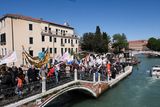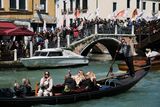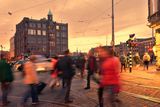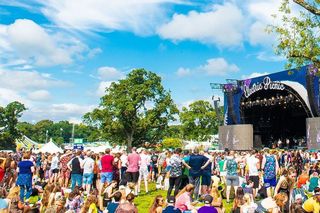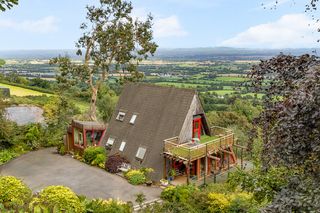Ireland's most haunted places - exploring scary stories and terrifying myths around the country
Author Gillian O'Brien takes us on a spooky tour of some of Ireland's landmarks with chilling tales of haunted castles and ghosts galore
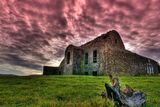
Halloween is a time for spooky tales around a fireside, the glow from the flickering flames illuminating the faces leaning in as the storyteller weaves stories of death, mystery and ghostly apparitions.
My father tells a story about his childhood in Athlone when he and his sister and his mother would walk past the Abbey graveyard on their way home at night.
Today, the graveyard is neat and tidy, with tombstones lined up against the walls, but back in the 1950s it was derelict, with headstones listing in all directions, graves exposed and human bones scattered over the ground.
It was a place where bored teenagers kept themselves entertained by terrifying passers-by. After dark they plucked skulls out of the graves and lit candles inside them. Then they hid behind the gravestones and waited.
Haunted... Leap castle in Offaly
As my grandmother approached pushing a pram, my young father trotting alongside, the teenagers would raise the illuminated skulls and bellow, "Goodnight Missus O'Brien!"
And every time my grandmother covered the half mile home in record time, the pram bouncing in front of her, my father scampering alongside.
Read more
Perhaps my father's formative experience helps explain why, as a child, I was terrified of ghost stories. The one I recall most clearly I first heard as an 11-year-old Cub Scout, sitting around a campfire near the Hellfire Club on Montpelier Hill in Co Dublin.
The Hellfire Club was a hunting lodge built in 1725 for William Conolly, the richest man in Ireland, but after his death it was taken over by a group of noblemen who drank, gambled and caroused there. There were rumours that they took part in satanic rituals, and at every meeting an empty chair was left for the Devil. Late one evening, the story goes, a handsome stranger arrived to play cards. He took the chair reserved for the Devil and refused to give it up.
As the night wore on, the members of the Hellfire Club grew more drunk, losing huge sums of money to the mysterious stranger, and when, as dawn broke, one of them bent down to pick a card, he noticed that the stranger had a cloven hoof.
The reveller screamed and, as he did so, the stranger disappeared, leaving behind only a smell of sulphur. That story kept me awake in my tent all night.
Versions of this story appear in many locations around Ireland, including Loftus Hall in Co Wexford and Castletown House in Co Kildare, and as I travelled around the country, researching my book The Darkness Echoing, I heard it time and again.
But I discovered many others too, for ghost stories are big business. Most of Ireland's prison museums offer ghost tours and there's hardly a castle without a knight haunting its ramparts, or a ghost in the dungeons rattling their chains.
These days I'm a little more sceptical than I was as a child, and I was doubtful I'd encounter any ghosts.
At Gothic Duckett's Grove near Carlow town, it's said that the sound of an organ can sometimes be heard while a ghostly foxhunt traverses the grounds, but on the day I visited, all I heard were the crows cawing as they flew in and out of the ruin.
Charles Fort in Kinsale tells a particularly tragic ghost story. Wilful Warrender, the 'White Lady of Kinsale', was the daughter of the fearsome Colonel Warrender, commander of Charles Fort in the late-17th century.
She fell in love with Trevor Ashurst, an officer at the fort, and they married. After the ceremony, as they walked along the ramparts, Wilful spotted some flowers growing on a rocky outcrop below.
Gillian O'Brien on the hunt for Ireland's most haunted spots
Her new husband persuaded the sentry to climb down and pick them, agreeing, in return, to take his place for night duty. This he did but, exhausted after the day's celebrations, Ashurst fell asleep.
Later that night, Colonel Warrender decided to inspect his nightwatchmen and soon came across the sleeping sentry. Outraged at this dereliction of duty, Warrender shot him dead before realising with horror that he had murdered his new son-in-law.
A distraught Wilful, still wearing her wedding dress, hurled herself from the ramparts, followed soon after by her devastated father.
Ever since, a ghostly woman in a wedding dress has been said to wreak havoc whenever she appears, though as with the foxhunt at Duckett's Grove, I saw no sign of her on my visit.
The story of the White Lady of Kinsale is hard to beat, but I couldn't complete my book without a visit to Leap Castle in Co Offaly, which claims to be the 'world's most haunted castle'.
The castle was built by the O'Carrolls in the 15th century, and many of the tormented souls said to haunt it are mercenaries the family betrayed. After a successful battle or raid, the mercenaries were invited to a celebratory banquet where they were poisoned.
Their fate wasn't the worst. Other unwelcome guests were thrown into a gap in the dining hall wall and fell several floors to the 'oubliette' (a dungeon) at the bottom.
The lucky ones landed on a spike; the unlucky were left to starve to death and forgotten, as the word oubliette suggests.
According to our guide, when the oubliette was emptied, hundreds of skeletons were discovered. No wonder their unhappy spirits are said to stalk the castle.
One of the best parts of a good ghost tour is observing the reactions of the other members of the tour group.
After our group had explored the castle, we returned to the fireside and listened to one of the visitors talk about how she'd felt the 'essence' of the place and it had filled her spirit with joy.
It seemed an odd reaction to a place where so many people had apparently been murdered, and I ventured a roll of my eyes at the woman beside me.
Then I noticed that she'd activated a ghost-hunting app on her phone and was staring at the electromagnetic field meter. I could see bars rising and falling on her screen. I decided it was time to leave.
I may have encountered no ghostly apparitions on my tour of Ireland, but I did have one disconcerting experience.
Late one evening I was in the stores of the National Museum at Collins Barracks with curator Brenda Malone, looking at artefacts associated with death.
As we sat there, surrounded by a smorgasbord of the macabre, we heard a loud metallic clatter ring out above us.
"Oh, that must be the security guard moving the metal trays," said Brenda. A few minutes later we heard women singing at the other end of the floor.
"That'll be the cleaners," Brenda said and we duly returned to admiring Michael Collins's beautifully embroidered slippers.
Later we went up to the floor with the trays. They hadn't been moved. And as we left the building, we ran into the security guard.
"No," he told us, "there haven't been any cleaners on our floor this evening. There hasn't been anyone at all."
I subsequently discovered that in the 18th century, when the site was a British military barracks, a young woman had attended a party hosted by officers. In the course of the evening, she fell from a window and later died from her injuries, but not before telling her doctor the officers had pushed her.
No one was ever charged with her murder, and now her ghost is said to walk the corridors seeking justice.
Since then I've been made sure that all my visits to the National Museum take place during the hours of daylight…just in case.
The Darkness Echoing: Exploring Ireland's Places of Famine, Death and Rebellion by Gillian O'Brien, published by Doubleday Ireland, is out now, €16.99.
Sign up for our free travel newsletter!
Like what you're reading? Subscribe to 'Travel Insider', our free travel newsletter written by award-winning Travel Editor, Pól Ó Conghaile.
Join the Irish Independent WhatsApp channel
Stay up to date with all the latest news



